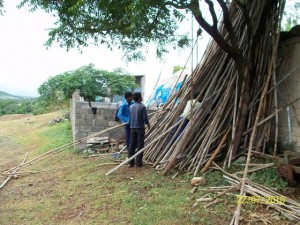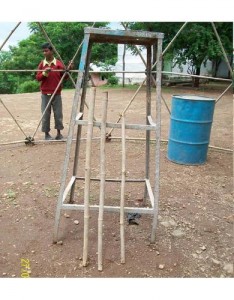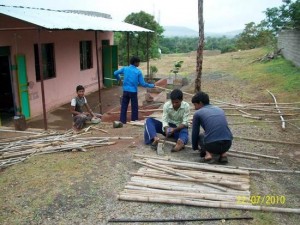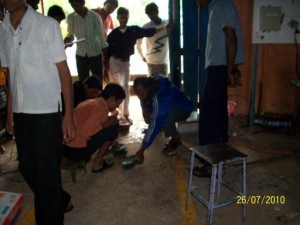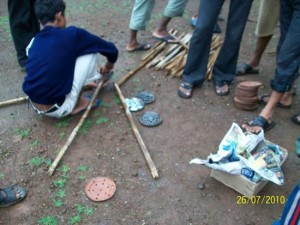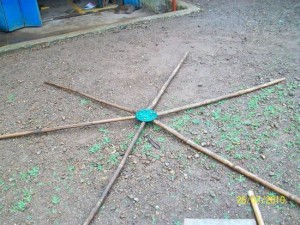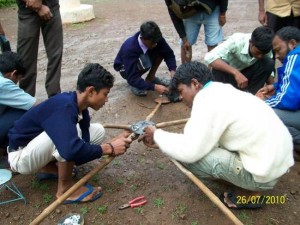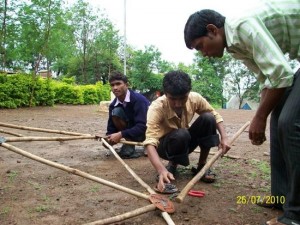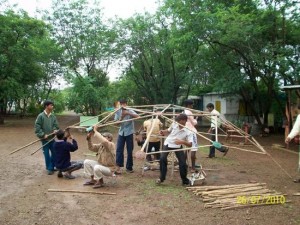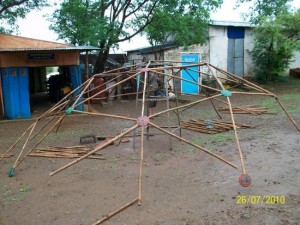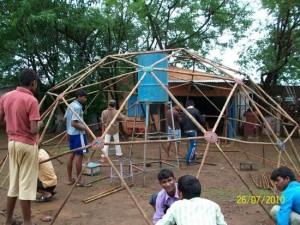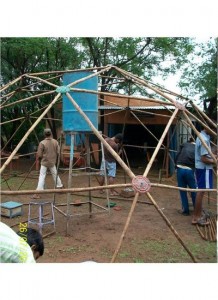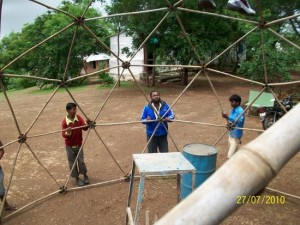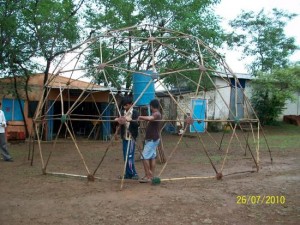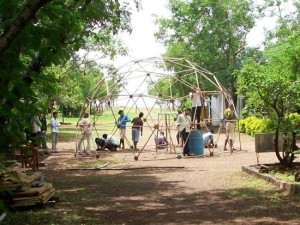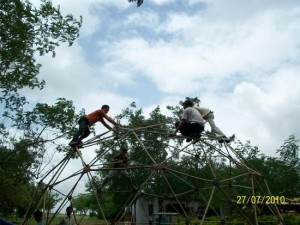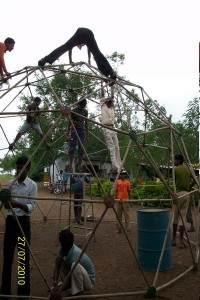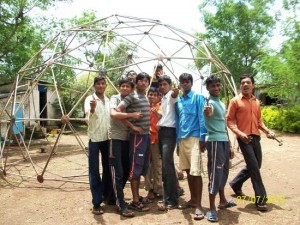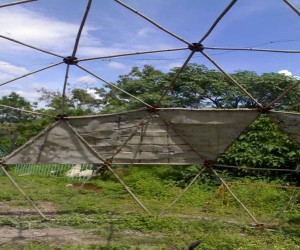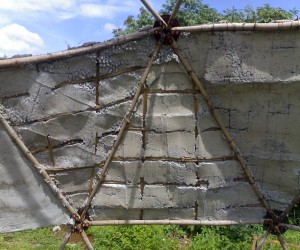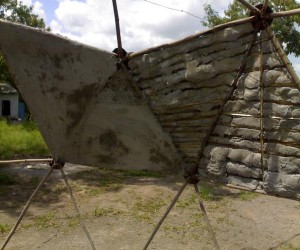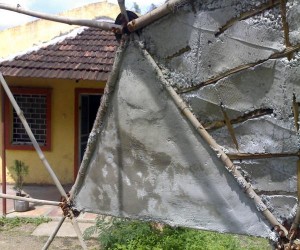Bamboo Dome construction
This page is a step-by-step construction of a 3V icosahedron bamboo geodesic dome set up at Vigyan Ashram, a village near Pune, Maharashtra, India.
| Click on images to enlarge | |
Selecting BamboosBamboos may be sold in any length that is found in nature, but the local market quotes a rate for 18 foot bamboo poles. The current rate is Rs 50 for a 18 foot pole that is approximately 1 inch in diameter or Rs 3 per running foot. Converted at Rs 46 = 1US dollar (current exchange rate) the bamboo price is 6 cents per running foot. Purchasing Power Parity (PPP) rate of Rs 9 =1US Dollar gives a better understanding of the bamboo rate. At PPP one inch thick bamboo costs 31 cents per running foot
|
|
Three Chords:Vigyan Ashram, where this bamboo dome is being built,has been a pioneer in construction of domes in India. The domes are mostly 3 frequency icosahedrons, as is this dome. The photograph displays the three chords leaning against a stand. The longest chord, the left most of three, is called ‘a’ chord. The middle chord which is just slightly shorter than ‘a’ chord, is called the ‘b’ chord. The shortest chord,on extreme right, is called the ‘c’ chord. The variations in chord lengths gives the dome its spherical shape.
|
|
Cutting Bamboos:Students enjoying themselves cutting the chords. At low frequencies, domes can be built without precision cutting tools. At higher frequencies, there are more vertices’s and each vertex tends to become flatter. That is dangerous to the structure and precision is then required.
|
|
Making Hubs:These Bamboo domes do use mild steel hubs to connect the chords. Links to one bamboo dome that uses no steel parts at all are given later on. Hubs are cut from scrap iron and have sets of holes drilled into them to accept the chords. The photo shows this activity in the workshop. Hubs and chords are bolted together with long screws and nuts.
|
|
Joining Chords to Hubs:When you start to build a dome you can opt to start from the top. Or you can build from the base. When you start from the top, the areas farthest from reach get done first on ground floor. The structure you are working with is always at the ground level. That is the way this dome is going to go up. Notice how pairs of holes have been drilled in the hubs.
|
|
Hexagon Center:Domes are built of various triangles assembled together. A 3 frequency triangle has a hexagon at its center. Chords that span out from the center are ‘c’ chords. You see one center assembly here.
|
|
Starting the Pentagon Center:Each Hexagon Hub is surrounded by a pentagon hub. Here five ‘a’ chords meet. The photograph shows the five ‘a’ chords being joined to the hub. As this dome is oriented, this will be the pentagon at the top. Though this picture does not show it, in between the hexagon hub and the pentagon hub a ‘b’ chord is fixed.
|
|
Pentagons and Hexagons Joined:The dome progress by joining five hexagons to the top pentagon. In the picture, the connecting ‘b’ chord is visible from the hands of the boy in blue to the middle of the left edge of the picture. You can also see part of the work done on other hexagons being added.
|
|
Ignition: Up She Goes.Note the use of make shift stool to prop the top.
|
|
One More Step:The Hexagons that are being attached to the top Pentagon are nearly done.
|
|
Stage 3 Firing:The Hexagons have been attached to the top Pentagon. See the oil drum placed on the top of the stool to push the dome higher.
|
|
Reaching Final Orbit:The top of the dome is higher than the oil drum prop. |
|
Supervising:The dome has gone too much higher than the oil drum so that has been taken down. Only a few items remain to be attached.
|
|
Reaching the End |
|
Peaceful Tightening:Once all parts have been joined, they screws need to be tightened. Look at the peaceful way the students are diligently working away |
|
Playfull Astronauts:I reached the site and instigated the students to go up the dome even though it was not fully tightened. First hesitatingly,then with joy,the students climbed up the dome.
|
|
Swinging Away:Students discover that the 1 inch dome will allow them to swing on it. The first hand experience will last them a life time.
|
|
The Assemblers and the Dome:The Assembly Team. This is the first Bamboo Dome at the Vigyan Ashram and possibly in a large part of India.
|
|
Converting the Bamboo Dome into a useful structure:Some attempts are being made to convert the bamboo dome into a useful structure at a low cost. Some of the triangles have been covered with ferro-crete or its equivalent.
|
|
Panels Covered with thin bamboo strips:An experiment was made to cover one triangular panel with thin bamboo strips. The concrete did not cover the bamboo strips uniformly and the gaps can be seen in the photograph.
|
|
Gaps and Chinks:Other similar covered panels also do not revel a better picture. Gaps and chinks can be seen within right hand side panels that were covered by bamboo strips |
|
Ferro-crete Panels:Vigyan Ashram has a long history of covering dome shells with ferro-crete. Chicken wire mesh is first spread over the panel. A layer of concrete is spread over the wire to cover the panel. Ferro-crete panels had no defects. Though no formal tests have yet been conducted, the panels sounded good and solid on being hit with a fist.
|
A C Mathur has put together this geodesic bamboo dome construction information . He maintains his own Wiki pages on the topic.

